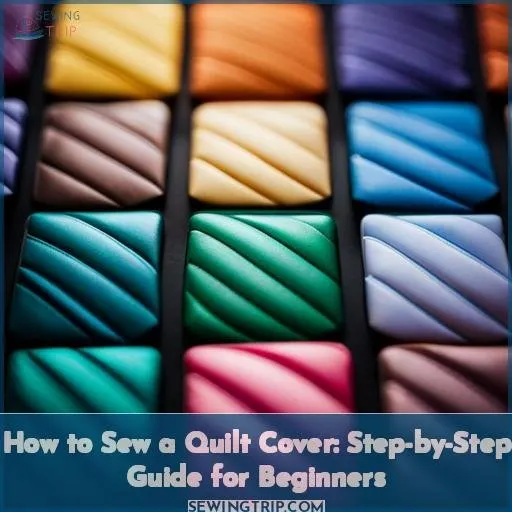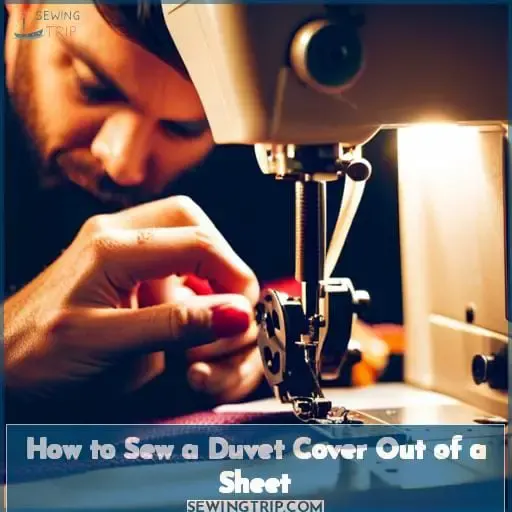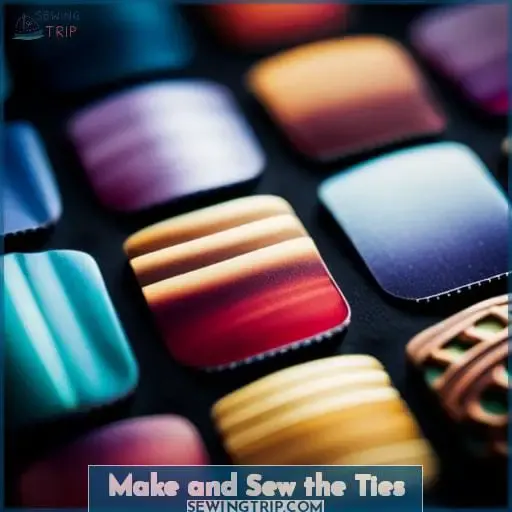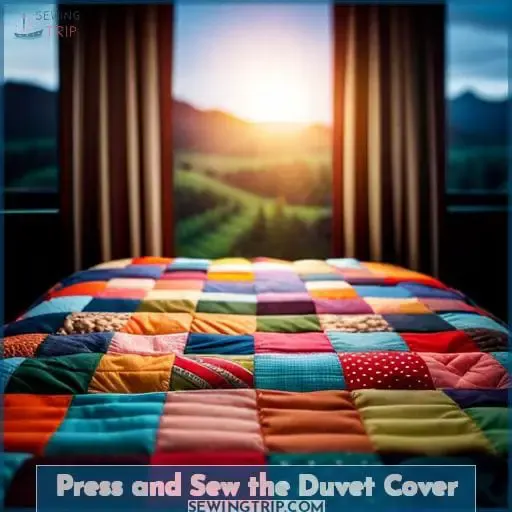This site is supported by our readers. We may earn a commission, at no cost to you, if you purchase through links.
Are you looking for a way to add some personality and style to your bedroom? Sewing your own quilt cover is a great way to do just that! With this step-by-step guide, even beginners can learn how to sew their very own quilt cover.
We will walk you through the process of finding the right size sheet, sewing it together, making ties, measuring and marking the top opening before pressing and finishing off your duvet cover.
So let’s get started learning how to sew a quilt cover!
Table Of Contents
- Key Takeaways
- How to Sew a Duvet Cover Out of a Sheet
- Find the Right Size Sheet
- Sew the Sheets Together
- Flip the Sheet Inside Out
- Make and Sew the Ties
- Measure, Mark, and Sew the Top Opening
- Press and Sew the Duvet Cover
- Finish Your Duvet Cover
- Tips for Decorating Your Home
- Frequently Asked Questions (FAQs)
- Conclusion
Key Takeaways

- Sewing your own quilt cover adds personality and style to your bedroom.
- Consider fabric requirements and shrinkage before starting.
- Measure your bed and comforter for a perfect fit.
- Use loops and fabric strips to keep the duvet cover in place.
How to Sew a Duvet Cover Out of a Sheet
Transform your bedroom with a new duvet cover, quickly and easily created from an existing sheet.
Before you start, be sure to double-check the measurements for both the comforter and fitted sheet. Fabric requirements vary depending on the width. Extra-wide fabric can work great, but if you opt for 45” or 60” wide fabric, you may need to add side sections.
Matching prints or stripes may require some extra material, while small prints don’t necessarily have to match perfectly.
To begin sewing, make a large hem at the open end of the sheet. Then stitch together the back and top sections before dividing the top opening into thirds and marking stitching lines along the edge.
Turn the hems under and secure them with topstitching. Then, place buttons or buttonholes around the flange as desired. Finally, attach loops or strips that will keep the comforter securely in place inside the duvet cover once it’s finished.
Enjoy total control over your bedding design today!
Find the Right Size Sheet
Before you start your duvet redesign, make sure to double-check the measurements of both your comforter and fitted sheet – different bed sizes have varying finished duvet measurements.
For example, a California King size requires up to 110 inches of fabric! Selecting the right type and width of fabric is vital for completing this project seamlessly. Seam allowances should be taken into account as well; extra-wide fabrics or even side sections may need to be added if using 45” or 60” wide material.
Hemming techniques also come in handy when it comes down to securing all edges – especially those at the end of the bed which can become disheveled over time with use!
Queen sheets are generally 90×108, while full-sized ones measure 81×96. Depending on how much coverage you’d like for a queen comforter/duvet, anywhere from three yards (108) to four yards (144) of 44-45 wide fabric would work best, so keep that in mind before making any purchases!
The same rule applies similarly for Full-size beds; just remember that some shrinkage may occur after washing, so always allow an additional few inches when selecting materials and cutting pieces out ahead of time.
With these tips in mind, creating beautiful bedroom decor can now easily become a reality today!
Sew the Sheets Together
Once the fabric is cut and prepped, it’s time to piece together your duvet. Start by adding trim or choose a patterned fabric for a great place to start. Adjust measurements according to bed size; queen sheets are generally 90×108 and full-sized 81×96.
Sew buttons along the flange of the duvet cover with loops for added security, as well as strips of fabric that help keep comforters in place.
A simple quick tip: Small prints may not require matching, while extra wide fabrics can be used for top sections but side pieces need 45” or 60” widths! Top edge stitching will divide openings into thirds, then zigzag or serge seams before turning hems under and topstitching them down – this helps prevent fraying too!
For an easy sizing guide, remember that any flat sheet can replace bottom sections, while using extra yardage on curtains/pillows makes sense aesthetically speaking – there you have it!
Flip the Sheet Inside Out
Now, flip your sheet inside out and you’re ready to start stitching. Did you know that it takes around 2-3 hours for a beginner to make their first duvet cover? When selecting fabric for the project, remember that extra wide fabrics can be used on top sections, but side pieces need 45 or 60 widths.
Adding trims is another great way to customize the look of your duvet. Sizing measurements should also be taken into account.
To finish off the edges of the duvet cover, zigzag or serge seams before turning hems under and topstitching them down. This helps prevent fraying too! Buttonholes placement follows after sewing buttons along the flange, with loops added as extra security alongside strips of fabric helping keep comforters in place.
Don’t forget about flipping over sides when working on the reverse side – and don’t forget open sides either! By adding a flat sheet at the bottom section instead, the same amount of fabric could save some time.
Make and Sew the Ties
To complete the look of your duvet, add ties to keep it snugly in place. When selecting fabric for creating ties, opt for a coordinating or complementing pattern that will blend with the overall design.
Before pressing seams and hemming edges to create small loops of fabric, make sure you have right sides together.
Attaching buttons is also recommended – try using ones that match or contrast with other fabrics used in the project! The best tip when sewing a quilt cover is to measure twice and cut once.
Finally, attach these loops on either side inside your duvet cover by stitching them down securely so they don’t come off after use.
Measure, Mark, and Sew the Top Opening
Measuring twice and marking the top opening of your duvet in thirds are key steps to giving it a polished look. To ensure accuracy, match up the fabric so that each side is even. Sew seams along the sides, then add buttons for extra coziness and make sure they coordinate with other patterns used in your bedding set.
Mark lines on either side to create flaps which will keep your king duvet comforter secure inside its cover! For those wanting something extra special, use the prettiest patterns you can find or mix different prints for an eclectic style – just be careful when choosing a new insert if you’re replacing an old comforter!
Finally, once all pieces have been stitched together neatly, you’ll have a beautiful quilt cover ready for snuggling into on cold nights – enjoy!
Press and Sew the Duvet Cover
After measuring and marking your duvet, it’s time to press and sew the fabric together.
Installing closures, selecting fabrics, and measuring the bed are all easy steps that will create a new friend for you to snuggle up with on cold nights!
Start by pressing each section of the fitted sheets before sewing them together. Make sure the seams are finished properly so they don’t fray over time.
Consider fabric widths when cutting out pieces. If you’re using 45 or 60-inch wide material, an extra side panel has to be added in order for it to fit around the entire quilt cover correctly.
The center section is then sewn at one end of the bottom piece, while another seam joins both sides along the top edge. This creates three separate openings which allow the comforter to be easily inserted between the two layers of cloth.
Lastly, add buttons or ties down the middle flap to keep everything secure inside its pristinely pressed casing!
Finish Your Duvet Cover
You’ve come to the last step in making your own duvet cover – adding the finishing touches. To make sure it looks perfect, consider adding trim for a more polished look. If you’re going with matching prints, factor in extra fabric when choosing what materials to use.
You may also need to create buttons and loops out of leftover fabric or thread from other projects for an easy way of securing the comforter inside its new home.
When all’s said and done, take careful measurements of your finished width before cutting any additional pieces; this will ensure that no mistakes are made along the way! With some patience and creativity, you’ll have created a one-of-a-kind masterpiece worthy of proudly displaying on any bed frame – now go show off your skills!
Tips for Decorating Your Home
Once you’ve finished your duvet cover, why not add a few decorative touches to spruce up the room? Accessorizing walls with coordinating colors can create an inviting atmosphere. When selecting prints for bedding and curtains, try repeating designs in different areas of the space.
Here are some tips:
- Cut widths twice as wide as what is needed for finished duvet covers.
- Incorporate the 3rd mark into the top section when creating buttons or loops.
- Add extra fabric if matching prints are desired.
- Choose small prints or stripes that don’t require matching pieces.
- Use extra-wide fabrics to eliminate side sections altogether.
With these suggestions, you can create an attractive design scheme without overspending! Create custom looks by pairing solid neutrals with vibrant accent hues – it’ll bring life back into any bedroom!
Frequently Asked Questions (FAQs)
What type of fabric should I use for my duvet cover?
Choose a fabric that will best suit your needs, such as cotton or a polyester blend. Consider the width and texture of the material to ensure it can easily fit over your comforter. Look for small prints or stripes that won’t require matching fabrics, but be prepared with extra fabric for trim if desired.
How do I make sure the duvet cover fits my bed?
Measure your bed and comforter to ensure that your duvet cover fits perfectly. Use extra fabric for matching designs or trim. Then, mark stitching lines on the top edge before hemming and adding buttons or loops to keep the comforter secure.
How do I make sure the duvet cover will stay in place?
To ensure that your duvet cover stays in place, you can add loops and fabric strips along the top edge. Stitch them securely to keep the comforter secure. If desired, you can also use buttons and buttonholes on the flange for extra stability.
What is the best way to prevent fraying of the fabric?
To prevent fraying, zigzag or serge the seams of your duvet cover. Imagine a needle and thread weaving in and out along the edges to create an additional secure layer that will keep the fabric intact for years to come.
How can I use my duvet cover to decorate my room?
Decorate your room with your duvet cover by adding complementary trim to curtains and pillows.
Conclusion
Your duvet cover project is now complete! With a few simple steps, you’ve just transformed a plain sheet into a cozy and beautiful duvet cover. It’s like changing a caterpillar into a butterfly – with a few simple steps, you can create something stunning.
Now that you have the tools to create your own duvet cover, you can easily customize any bedroom in your home. You can make your duvet cover the focal point of the room or use it to match the other design elements in your room.















